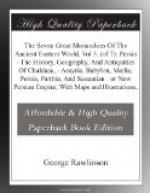The winged human-headed bulls, which the Persians adopted from the Assyrians, with very slight modifications, were also, it is probable, regarded as emblems of some god or good genius. They would scarcely otherwise have been represented on Persian cylinders as upholding the emblem of Ormazd in the same way that human-headed bulls uphold the similar emblem of Asshur on Assyrian cylinders. [PLATE LX., Fig. 2.] Their position, too, at Persepolis, where they kept watch over the entrance to the palace, accords with the notion that they represented guardian spirits, objects of the favorable regard of the Persians. Yet this view is not wholly free from difficulty. The bull appears in the bas-reliefs of Persepolis among the evil, or at any rate hostile, powers, which the king combats and slays; and though in these representations the animal is not winged or human-headed, yet on some cylinders apparently Persian, the monarch contends with bulls of exactly the same type as that which is assigned in other cylinders to the upholders of Ormazd. It would seem therefore that in this case the symbolism was less simple than usual, the bull in certain combinations and positions representing a god or a good spirit, while in others he was the type of a deva or evil genius.
[[Illustration: PLATE LX.]
The most common representatives of the Evil Powers of the mythology were lions, winged or unwinged, and monsters of several different descriptions. At Persepolis the lions which the king stabs or strangles are of the natural shape, and this type is found also upon gems and cylinders; but on these last the king’s antagonist is often a winged, while sometimes he is a winged and horned, lion. [PLATE LX., Fig. 3.] The monsters are of two principal types. In both the forms of a bird and a beast are commingled; but in the one the bird, and in the other the beast predominates. Specimens are given [PLATE LX., Fig. 4] taken from Persian gems and cylinders.
Such seems to have been, in outline, the purer and more ancient form of the Persian religion. During its continuance a fierce iconoclastic spirit animated the princes of the Empire, who took every opportunity of showing their hatred and contempt for the idolatries of the neighboring nations, burning temples, confiscating or destroying images, scourging or slaying idolatrous priests, putting a stop to festivals, disturbing tombs, smiting with the sword animals believed to be divine incarnations. Within their own dominions the fear of stirring up religious wars compelled them to be moderately tolerant, unless it were after rebellion, when a province lay at their mercy; but when they invaded foreign countries, they were wont to exhibit in the most open and striking way their aversion to materialistic religions. In Greece, during the great invasion, they burned every temple that they came near; in Egypt, on their first attack, they outraged every religious feeling of the people.




